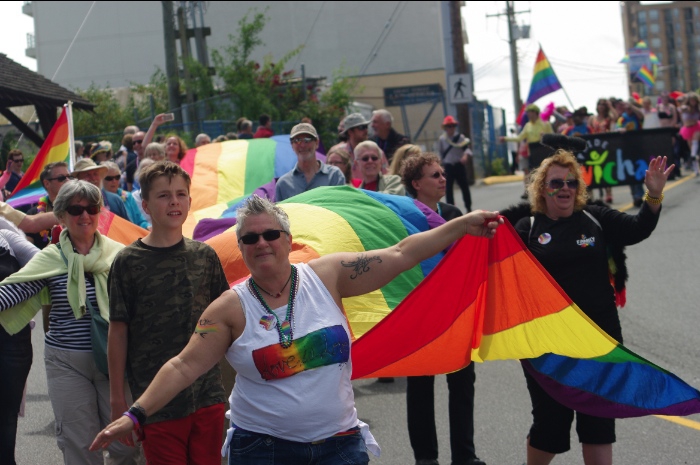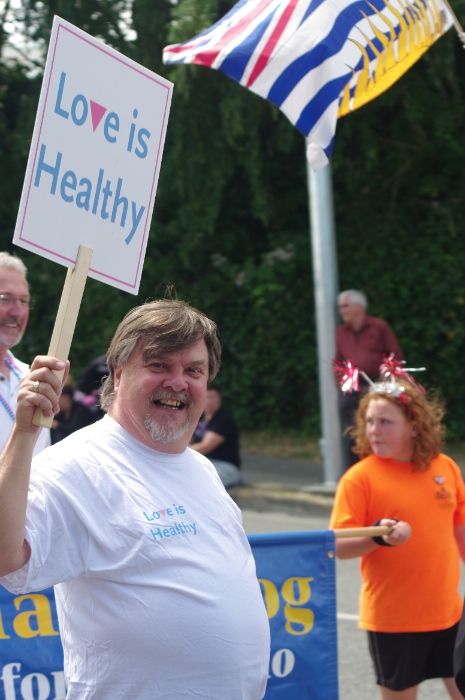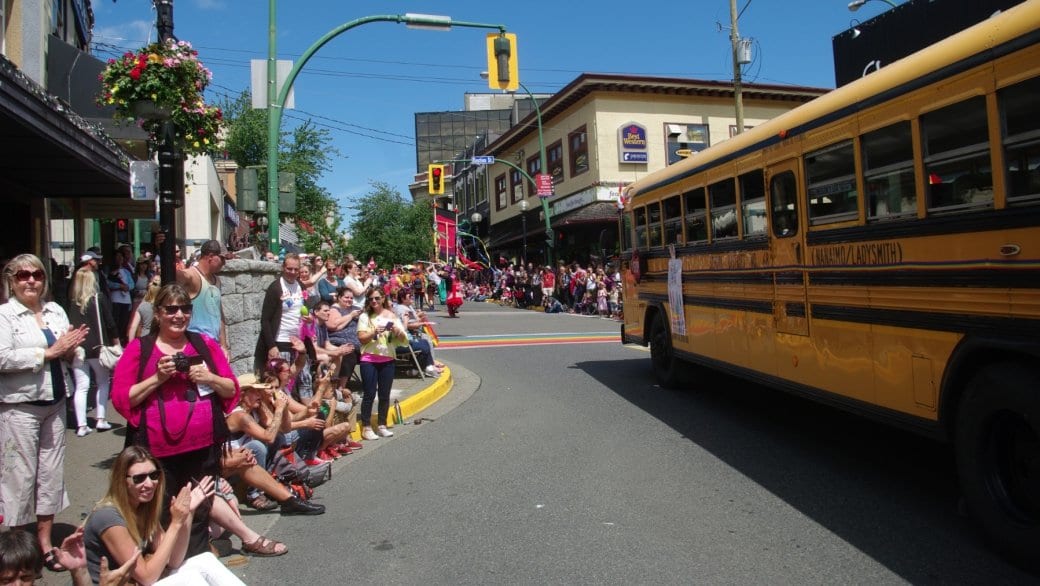My first gay Pride parade was an unforgettable experience, but it certainly didn’t take place in my hometown.
“Rather than receive stares of ridicule and disgust I received looks of admiration, love and respect,” I wrote at the time. “Pride flags adorned every balcony and store window, thousands of people were cheering for me simply because I am who I am.”
“I have yet to receive such acclaim in Nanaimo,” I added.
That was 1999.
Back then I longed to see little rainbow stickers in Nanaimo’s business windows, gay and lesbian couples walking down the street holding hands without fear of being bashed and, someday, a Pride parade.
That someday finally came on June 12, 2016.
Nanaimo’s first Pride parade looked and felt much like every other Pride parade I’ve attended.
Almost everyone was decked out in rainbow colours, and Pride flags fluttered between the glut of pedestrians crisscrossing the parade route to greet friends.
The crowd of onlookers and well-wishers appeared to be three to five rows deep throughout the route.
As I walked alongside the parade route, I scanned the crowd for any sign of opposition to the day’s event, but my focus was interrupted by people who broke out from the crowds to wish me a happy Pride.
“It’s not like the ’90s anymore,” says Justin Capson, a volunteer for the Nanaimo Pride Society and my first foster brother. “It was different then. I remember there was Youthquest and that was the haven for a lot of people.”

(Parade goers flutter a long rainbow through downtown Nanaimo./Nathaniel Christopher/Daily Xtra)
I remember our Youthquest days too. Every Thursday night I would douse my hair in gel, put on my gayest orange shirt and rainbow necklace and sneak off to a discreet brick building at the corner of Commercial and Terminal in the heart of downtown Nanaimo.
We’d talk, watch movies, listen to the latest CD singles purchased at the A&B Sound across the street and dream about our future.
In the late 1990s and early 2000s, my dear friend David Reid was an adult volunteer there.
I spot him in the shade of an Edwardian brick storefront with his co-workers from Island Health at the parade.
“The PR people at Island Health were totally on board with getting organized for this,” he says. “When I came here 19 years ago my first boss was so homophobic that she couldn’t fathom having a gay man working on her staff.”
As a youth I never fathomed the possibility that I could live as a happy and healthy out gay man in Nanaimo. The fact that I was gay meant that I would have to move to a more gay-friendly city like Victoria or Vancouver.
My teachers, social worker and network of friends were incredibly supportive but they could not always protect me from anti-gay verbal and physical attacks that became part and parcel of my long walks home from school.
So on Jan 31, 2000, my last day of high school, I packed all of my worldly possessions into the back of my youth worker’s truck and took the ferry to Horseshoe Bay. I have not lived in Nanaimo since.
Back then David encouraged me to follow my dreams and move to Vancouver. Now, he tells me, “you could live here again if you wanted to.”

(David Reid walks in Nanaimo’s first Pride parade./Nathaniel Christopher/Daily Xtra)
David’s only disappointment with the parade: that it didn’t go by former mayor Gary Korpan’s house. Korpan consistently refused to sign Pride proclamations or attend Pride flag-raising ceremonies during his 15-year tenure.
“I do think maybe the parade should have wound past his house and stopped in front of it for a while with the music as loud as possible,” David says. “But you can’t have everything!”
I interviewed Korpan and other local politicians about the plight of Nanaimo’s gay and lesbian youth in 1999.
“What’s the first thing that comes to your mind when you think of gay and lesbian youth?” I asked.
“I don’t recall ever having thought about it,” Korpan replied.
“What do you know about the problems facing gay and lesbian youth in Nanaimo?” I continued.
“Well, I imagine like any community there are always people who take offence to that lifestyle and activity. Some of the more outraged might make violent threats, I might imagine.”
Shortly after the parade, I phoned Korpan and asked for his thoughts on the event.
“I haven’t heard anything about it,” he replied. “Nobody’s brought this to my attention.”
“Do you still hold the same views on gay Pride events that you did in 1999?” I asked.
“I don’t have any comment,” he said and hung up.

(Justin Capson volunteers with the Nanaimo Pride Society./Nathaniel Christopher/Daily Xtra)
Justin assures me that I’d have to search the crowds pretty hard to find anyone opposed to the parade today.
“It’s all about diversity and acceptance now,” he beams. “We saw more than 300 people at this year’s Pride flag-raising and we only had 25 at the last year so it’s showing you that there is change in this town and if there are any homophobic people here then we’ve out numbered them by far.”
He says there are more than 50 parade entrants, including many last-minute submissions.
School District 68 is out in full-force with district staff and students flanking a large yellow school bus.
I scan the flutter of rainbow flags and boas for familiar faces and spot Robyn Kemp, who was my teacher at a district behaviour class in 1990 and 1991.
“Apparently this is the largest turnout for any parade that’s ever happened in Nanaimo and it’s happened for the very first Pride parade,” Robyn says. “It’s a first for Nanaimo and it’s a first for our school district.”
She now works as one of the district’s social justice advocates and is helping the district realize the goals set out in its new inclusion policy that mentions race, sexual orientation, gender identity, ability, religion, culture and socioeconomic status.
“It’s about looking at how many people are marginalized and don’t get equal opportunities in our school district to really fulfil their potential,” she explains.

(Robyn Kemp is helping the Nanaimo school district implement its new inclusion policy./Nathaniel Christopher/Daily Xtra)
The parade ends with a festival at Maffeo Sutton Park on Nanaimo’s waterfront, where I run into my old friend Bill Bard.
“If you look at what’s happened in this city in the past, where it wasn’t safe for kids to go to school and it was only in recent years that we got gender-neutral washrooms approved in schools, then it’s pretty amazing to see this many thousands of people show up to support queer rights and the community,” says Bill, who served as school board trustee from 2011 until 2014.
Bill was the city’s first openly gay elected representative and one of the first out and proud adults I ever met.
“Can you believe that this actually took place in Nanaimo?” I ask, as the last of the vendors fold up their tables.
“We are a labour focus town, a trades town and a resources town so there’s a stereotype of us being homophobes,” he says. “But we’ve come out of that now. Look around and see how many people have come out to support us.”
“That is really society saying: we accept this and we’re not like that anymore,” he says.
“It’s Nanaimo coming out and saying, ‘we love you too.’”

 Why you can trust Xtra
Why you can trust Xtra


